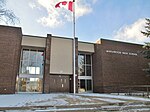Guild Inn
Burned buildings and structures in CanadaDefunct hotels in CanadaDemolished buildings and structures in TorontoHistory of TorontoHotels in Toronto ... and 4 more
Houses completed in 1914Pages with non-numeric formatnum argumentsScarborough, TorontoUse mdy dates from September 2016

The Guild Inn, or simply The Guild was a historic hotel in the Guildwood neighbourhood of Scarborough, Toronto, Ontario and was once an artists colony. The surrounding Guild Park and Gardens is notable for a sculpture garden consisting of the rescued facades and ruins of various demolished downtown Toronto buildings such as bank buildings, the old Toronto Star building and the Granite Club. The park is situated on the Scarborough Bluffs with views of Lake Ontario. Guild Park remained open and the refurbishment of the Guild Inn into a facility for social events was completed in May 2017.
Excerpt from the Wikipedia article Guild Inn (License: CC BY-SA 3.0, Authors, Images).Guild Inn
Guildwood Parkway, Toronto Scarborough
Geographical coordinates (GPS) Address External links Nearby Places Show on map
Geographical coordinates (GPS)
| Latitude | Longitude |
|---|---|
| N 43.747638888889 ° | E -79.192222222222 ° |
Address
Guild Inn
Guildwood Parkway
M1E 1R3 Toronto, Scarborough
Ontario, Canada
Open on Google Maps








